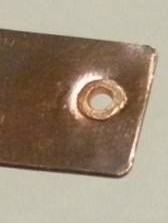- NEW DVD Series – Stone Setting with Bezels
- Tube Set Charm by Kim St. Jean
- Prong Basket Pendant by Kim St. Jean
- NEW DVD Series – Stone Setting with Cold Connections
- New DVD Series – Stone Setting with Wire
- NEW DVD Series: Introduction to Stone Setting by Kim St. Jean
- Featured Tool: Bracelet Bending Plier
- NEW Dvd by Eva Sherman
- Fun, Fast Fold Forming DVD Series
- Double Band Ear Cuff from Alex Simkin
A History of Beading
The art of stringing beads together has been known to mankind since ancient times and has been practiced for many reasons including symbolizing religious beliefs. Back in the ancient world tribes used the bones of wild animals and would string them onto fibers and would then wear them for protection believing that they would be safe from bad spirits.
As human civilization advanced beading progressed as a result of man learning how to pierce objects through drilling holes. Necklaces would be created from many objects that would include seashells, seed pods and nut shells as well as many other objects. Bead development would eventually progress with the coloring of beads. Clay beads would often be coated in enamel
The Egyptians were masters of glass making and they would revolutionize bead making as glass beads were far more beautiful and could be used to make the most wonderful necklaces. They would use glass that would come in many different colors and they would combine these colored glass beads with gemstones, both precious and semi-precious. Gold and silver would also be added.
There would be a great demand for beads and they would become a valuable trading commodity that would be exported and traded all around the world since ancient times. Many cultures would embrace beading especially the Chinese, Babylonians and in ancient India.
Beading development would also be greatly influenced by the Romans as they would trade their beads throughout the Roman Empire. This influence would spread to the Celts and the Vikings who would use beads to make wonderful bracelets, necklaces and amulets. Beading would also be embraced by the Native American Indians whose works are still used today in the latest fashions such as in turquoise colored watch bands, necklaces and belts.
Beading was and still is an integral part of Native American culture. Many Indian tribes in the Americas would train their womenfolk at becoming adept in the beading arts. A technique known as bead quilling was considered to be sacred. The workmanship and art of bead quilling was considered sacred and not the finished beaded items themselves. That is rather different to the norm in Western societies where the finished product is what is valued most and not the workmanship that created it.
For more information and ideas about beads, beading and beads history please visit https://www.beadyeyez.com























0 comments